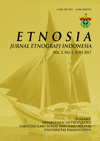Abstract
Multilevel marketing (MLM) is one of the marketing strategy which combines between distribution channel and direct selling to the consumers. One of the most popular MLM companies in Indonesia registered in the Indonesian Direct Sale Association (Assosiasi Penjualaan Langsung Indonesia, APLI) is PT. Orindo Alam Ayu, known as Oriflame, and is focused on beauty products. This article deals with Oriflame’s organisational culture by examining the organisational values and norms to achieve the company’s vision and mission, and how the norms are practiced. The study indicates that in internalizing the values (togetherness, spirit, and passion) and norms of Oriflame (operational principles, conducting a four-in-one events—Welcome Party, Step-One, Step-Two and Meet-Up Team, and success plan through TRB), from which Oriflame consultants learn how ‘to achieve their dream’ (mewujudkan mimpi). In such business, every consultant (upline as well as downline) is a working partner and they workin a complementary system, so that a consultant’s success is the success of others in the network. It is argued in this article that Oriflame is ‘an achievement dream business’ that is developed on the basis of its values and norms. How much income and in what level of success plan are intended to achieve depend on the consultant itself because Oriflame business is ‘the business of the consultant herself/himself’.





